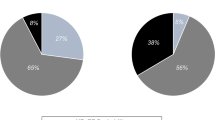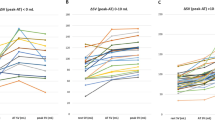Abstract
Background
Detecting heart failure (HF) patients at risk is a relevant clinical problem. Our goal was to define associations of clinical HF-markers and exercise parameters with respect to their prognostic power in HF-patients.
Methods
We performed cardiopulmonary exercise testing (CPET) in 103 ischemic HF-patients. CPET-parameters included peak VO2, VO2 at AT, peak oxygen pulse, minimal CO2 and O2 equivalents, VE/VCO2 and s1, a motivation-independent and submaximal parameter representing the initial slope of the VCO2/VO2-curve that has not been described in HF-patients so far.
Results
Median follow-up was 668 days. The combined endpoint of cardiovascular death and rehospitalization due to HF occurred in 14 patients. Patients with/without events differed significantly regarding their age, NYHA-class, LVEF and NT-proBNP serum-levels. Patients with events had significantly lower peak VO2- and higher s1-values. NT-proBNP serum-levels, NYHA-class and LVEF were significantly correlated with peak VO2. Only age, peak VO2 and s1 were independent predictors of adverse events. Using multivariate analysis, s1 was a strong and independent parameter with good sensitivity and specificity.
Conclusion
s1 is an independent and powerful predictor in HF-patients. Since s1 is independent of maximal exercise capacity, s1 might be more accurate for the evaluation of HF-patients not willing or unable to perform maximal exercise.





Similar content being viewed by others
Abbreviations
- AT:
-
Anaerobic threshold
- AUROC:
-
Area under the receiver operating characteristic curve
- ACE:
-
Angiotensin converting enzyme
- ARB:
-
Angiotensin receptor blocker
- NT-proBNP:
-
N-terminal pro-brain natriuretic peptide
- CAD:
-
Coronary artery disease
- CHF:
-
Chronic heart failure
- CPET:
-
Cardiopulmonary exercise test
- CI:
-
Confidence interval
- EqCO2 :
-
Ventilatory equivalent for CO2-exhalation
- EqO2 :
-
Ventilatory equivalent for O2-inhalation
- EqO2 min, EqCO2 min:
-
Minimal ventilatory equivalents for O2- and Co2-exchange
- LVEF:
-
Left ventricular ejection fraction
- Peak VO2 :
-
Peak oxygen uptake
- Peak O2 pulse:
-
Peak oxygen uptake, adjusted to corresponding heart rate
- RER:
-
Respiratory exchange ratio
- RR:
-
Relative risk
- S1:
-
Initial slope of the VCO2/VO2-curve
- NYHA:
-
New York heart association
- VE:
-
Minute ventilation
- VE/VCO2 :
-
Slope of the VE/VCO2 curve
- VO2 AT:
-
Oxygen uptake at the anaerobic threshold
References
(1999) The cardiac insufficiency bisoprolol study II (CIBIS-II): a randomised trial. Lancet 353:9–13
Baba R, Nagashima M, Goto M, et al (1996) Oxygen uptake efficiency slope: a new index of cardiorespiratory functional reserve derived from the relation between oxygen uptake and minute ventilation during incremental exercise. J Am Coll Cardiol 28:1567–1572
Basat O, Ucak S, Seber S, Oztekin E, Altuntas Y (2006) After myocardial infarction carvedilol improves insulin resistance compared to metoprolol. Clin Res Cardiol 95:99–104
Beaver WL, Wasserman K, Whipp BJ (1986) A new method for detecting anaerobic threshold by gas exchange. J Appl Physiol 60:2020–2027
Bohm M, Werner N, Kindermann M (2006) Drug treatment of chronic heart failure. Clin Res Cardiol 95(Suppl 4):36–54; quiz 55–56
Bruce RA, Blackmon JR, Jones JW, Strait G (1963) Exercising testing in adult normal subjects and cardiac patients. Pediatrics 32(suppl):742–756
Buller NP, Poole-Wilson PA (1988) Extrapolated maximal oxygen consumption: a new method for the objective analysis of respiratory gas exchange during exercise. Br Heart J 59:212–217
Chua TP, Ponikowski P, Harrington D, et al (1997) Clinical correlates and prognostic significance of the ventilatory response to exercise in chronic heart failure. J Am Coll Cardiol 29:1585–1590
Cohn JN, Johnson GR, Shabetai R, et al (1993) Ejection fraction, peak exercise oxygen consumption, cardiothoracic ratio, ventricular arrhythmias, and plasma norepinephrine as determinants of prognosis in heart failure. the V-HeFT VA Cooperative Studies Group. Circulation 87:VI5–VI16
Cooper CB, Beaver WL, Cooper DM, Wasserman K (1992) Factors affecting the components of the alveolar CO2 output-O2 uptake relationship during incremental exercise in man. Exp Physiol 77:51–64
Cowie MR, Mosterd A, Wood DA, et al (1997) The epidemiology of heart failure. Eur Heart J 18:208–225
Davies LC, Francis DP, Piepoli M, Scott AC, Ponikowski P, Coats AJ (2000) Chronic heart failure in the elderly: value of cardiopulmonary exercise testing in risk stratification. Heart 83:147–151
Davies LC, Wensel R, Georgiadou P, et al (2006) Enhanced prognostic value from cardiopulmonary exercise testing in chronic heart failure by non-linear analysis: oxygen uptake efficiency slope. Eur Heart J 27:684–690
Francis DP, Shamim W, Davies LC, et al (2000) Cardiopulmonary exercise testing for prognosis in chronic heart failure: continuous and independent prognostic value from VE/VCO(2) slope and peak VO(2). Eur Heart J 21:154–161
Gitt AK, Wasserman K, Kilkowski C, et al (2002) Exercise anaerobic threshold and ventilatory efficiency identify heart failure patients for high risk of early death. Circulation 106:3079–3084
Ingle L, Goode K, Carroll S, et al (2007) Prognostic value of the VE/VCO2 slope calculated from different time intervals in patients with suspected heart failure. Int J Cardiol 118:350–355
Kleber FX, Vietzke G, Wernecke KD, et al (2000) Impairment of ventilatory efficiency in heart failure: prognostic impact. Circulation 101:2803–2809
Krumholz HM, Chen YT, Wang Y, Vaccarino V, Radford MJ, Horwitz RI (2000) Predictors of readmission among elderly survivors of admission with heart failure. Am Heart J 139:72–77
Lavie CJ, Milani RV, Mehra MR (2004) Peak exercise oxygen pulse and prognosis in chronic heart failure. Am J Cardiol 93:588–593
Lipkin DP, Jones DA, Round JM, Poole-Wilson PA (1988) Abnormalities of skeletal muscle in patients with chronic heart failure. Int J Cardiol 18:187–195
Mancini DM, Eisen H, Kussmaul W, Mull R, Edmunds LH Jr, Wilson JR (1991) Value of peak exercise oxygen consumption for optimal timing of cardiac transplantation in ambulatory patients with heart failure. Circulation 83:778–786
Mudge GH, Goldstein S, Addonizio LJ, et al (1993) 24th Bethesda conference: cardiac transplantation. Task force 3: recipient guidelines/prioritization. J Am Coll Cardiol 22:21–31
Myers J, Gullestad L, Vagelos R, et al (2000) Cardiopulmonary exercise testing and prognosis in severe heart failure: 14 ml/kg/min revisited. Am Heart J 139:78–84
Norozi K, Wessel A, Buchhorn R, et al (2007) Is the ability index superior to the NYHA classification for assessing heart failure?: comparison of two classification scales in adolescents and adults with operated congenital heart defects. Clin Res Cardiol 96:542–547
O’Neill JO, Young JB, Pothier CE, Lauer MS (2005) Peak oxygen consumption as a predictor of death in patients with heart failure receiving beta-blockers. Circulation 111:2313–2318
Packer M, Fowler MB, Roecker EB, et al (2002) Effect of carvedilol on the morbidity of patients with severe chronic heart failure: results of the carvedilol prospective randomized cumulative survival (COPERNICUS) study. Circulation 106:2194–2199
Peters-Klimm F, Muller-Tasch T, Schellberg D, et al. (2007) Guideline adherence for pharmacotherapy of chronic systolic heart failure in general practice: a closer look on evidence-based therapy. Clin Res Cardiol 97(4):244–252
Pitt B, Williams G, Remme W, et al (2001) The EPHESUS trial: eplerenone in patients with heart failure due to systolic dysfunction complicating acute myocardial infarction. Eplerenone post-AMI heart failure efficacy and survival study. Cardiovasc Drugs Ther 15:79–87
Poole-Wilson PA, Buller NP, Lipkin DP (1988) Regional blood flow, muscle strength and skeletal muscle histology in severe congestive heart failure. Am J Cardiol 62:49E–52E
Reybrouck T, Mertens L, Schepers D, Vinckx J, Gewillig M (1997) Assessment of cardiorespiratory exercise function in obese children and adolescents by body mass-independent parameters. Eur J Appl Physiol Occup Physiol 75:478–483
Robbins M, Francis G, Pashkow FJ, et al (1999) Ventilatory and heart rate responses to exercise: better predictors of heart failure mortality than peak oxygen consumption. Circulation 100:2411–2417
Schuler J, Maier B, Behrens S, Thimme W (2006) Present treatment of acute myocardial infarction in patients over 75 years–data from the Berlin myocardial infarction registry (BHIR). Clin Res Cardiol 95:360–367
Shakar SF, Lowes BD, Lindenfeld J, et al (2004) Peak oxygen consumption and outcome in heart failure patients chronically treated with beta-blockers. J Card Fail 10:15–20
Simon T, Becker R, Voss F, et al (2008) Elevated B-type natriuretic peptide levels in patients with nonischemic cardiomyopathy predict occurrence of arrhythmic events. Clin Res Cardiol 97(5):306–309
Stevenson LW (1996) Selection and management of candidates for heart transplantation. Curr Opin Cardiol 11:166–173
Voller H (2006) Significance of changes in habits followed by risk reduction. Clin Res Cardiol 95(Suppl 6):VI6–VI11
Yasaka Y, Yamabe H, Yokoyama M (1997) Dependence of peak oxygen uptake on oxygen transport capacity in chronic heart failure: comparison of graded protocol and fixed protocol. Int J Cardiol 59:149–156
Zugck C, Haunstetter A, Kruger C, et al (2002) Impact of beta-blocker treatment on the prognostic value of currently used risk predictors in congestive heart failure. J Am Coll Cardiol 39:1615–1622
Author information
Authors and Affiliations
Corresponding author
Rights and permissions
About this article
Cite this article
Honold, J., Geiger, L., Assmus, B. et al. The initial slope of the VCO2/VO2-curve (s1) in cardiopulmonary exercise testing is a strong and independent predictor of outcome in patients with previous myocardial infarction. Clin Res Cardiol 97, 882–890 (2008). https://doi.org/10.1007/s00392-008-701-6
Received:
Accepted:
Published:
Issue Date:
DOI: https://doi.org/10.1007/s00392-008-701-6




